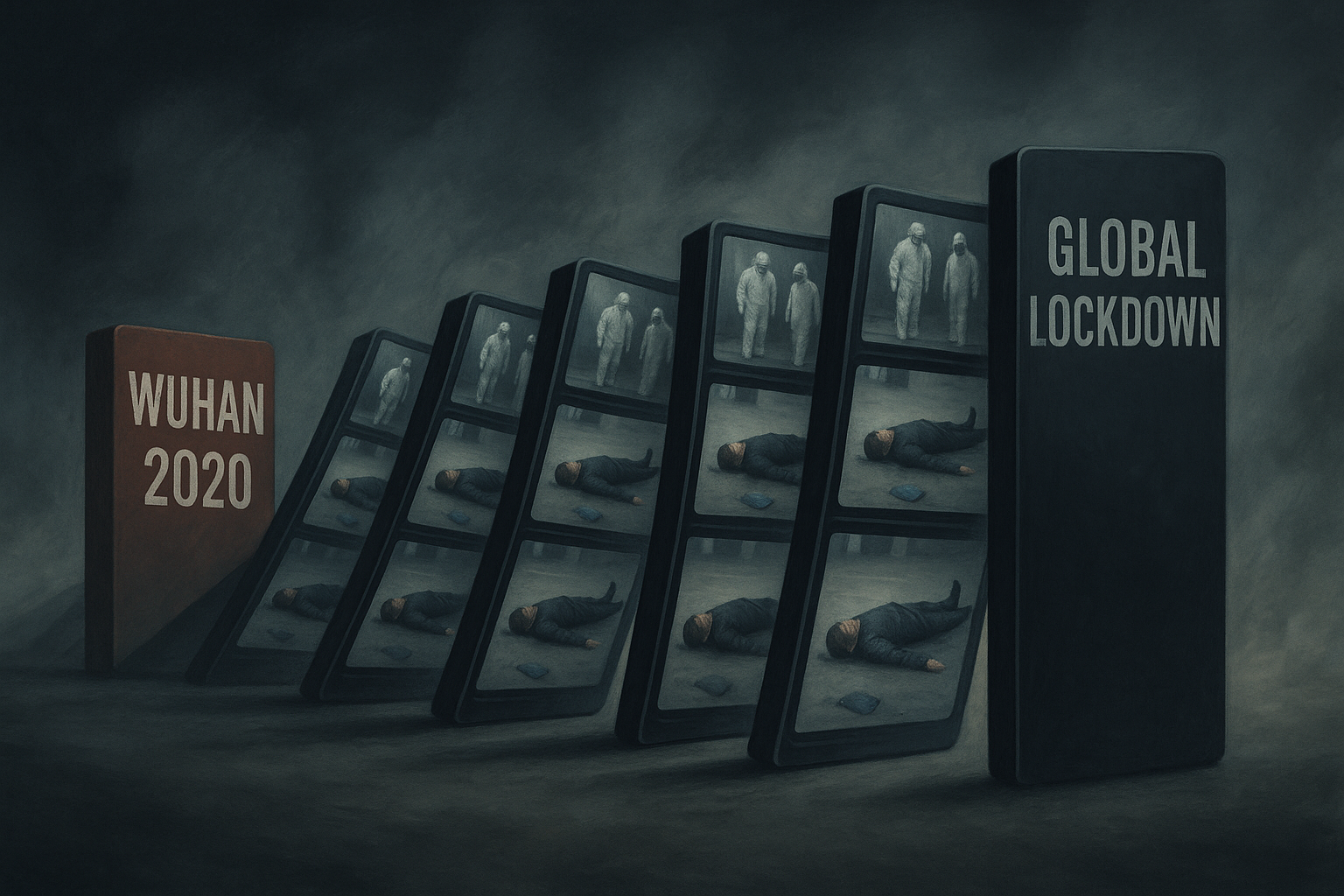
In early 2020, a torrent of harrowing videos and photographs came out of China depicting victims supposedly being ambushed by a deadly contagious disease that was being called “coronavirus.” The alarming visuals shocked and terrorized populations from East to West.
Some scenes showed people collapsing on the streets and dying on the spot. Others showed victims foaming at the mouth. We saw frightening images of dead bodies piling up and equally ominous images of government officials in hazmat suits hovering over these lifeless bodies.
It was understandable that such haunting images not only created a worldwide frenzy of fear and hysteria but also set the stage for what would become an unprecedented series of global lockdowns and an unmatched epoch of medical tyranny.
But . . . there was one big problem with these deadly depictions and viral videos. Upon closer examination, all of them appeared to be fakes and fabrications.
That’s right. The images launched “round the world” that ignited the coronavirus mass hysteria campaign, which in turn led to worldwide lockdowns and incalculable destruction, were staged artifacts of mass media manipulation.
Example #1: A video out of Wuhan, China, was said to be evidence of the deadly effects of the “new coronavirus.”
Though this video is no longer available, when it circulated widely on social media, it apparently showed a pile of “covid victims” covered in blankets waiting to be picked up and carted away. The hype that accompanied the scene claimed that China was dealing with “no ordinary virus.” The video provocatively asked, “Is it [an] intentionally released bio-weapon?” The question had the effect of seeding in the global public’s consciousness a possible “alternative explanation” for this enigmatic pathogen.
It was later revealed that the Wuhan “body pile” video was in reality showing people sleeping in the streets in Shenzhen, China—more than 600 miles away from its supposed source. But why were so many Chinese subject to such a sad predicament? It seems the government had set up a permit system for entering and exiting the city to prevent the spread of “the virus,” and these victims were not issued the requisite permits.
Example #2: Another video out of China the same year panned on a poor man who was vomiting blood.
This gory video showing a man riding on public transportation and puking up blood was posted on Instagram on January 29, 2020. The caption alongside the video suggested that the man was infected with a new coronavirus strain (the “Wuhan virus”). The story hysterically (and falsely) implied that he was experiencing “violent coronavirus symptoms.”
Yet, upon investigation, it was revealed that the video in question dated back to February 14, 2019, and stemmed from an incident involving a 52-year-old male passenger traveling on the Chonqing Rail Transit who had fainted, vomited blood, and died. A review of his medical history found that he suffered from advanced liver cancer.
Example #3: A man who collapsed at an airport in Thailand was said to have been a victim of Covid.
When a Facebook user posted the photo of a Chinese man lying face down on the floor of a Thailand airport, the image naturally went viral. Naturally, too, the media insinuated that his plight was caused by “the virus.”
The strange and scary caption read: “At the airport right now, a Chinese person is suddenly knocked to the ground. The third floor is under control. The government is really taking care of it. No more photos allowed. It’s very scary.”
This made-for-TV extraterrestrial-like interpretation of his condition was ultimately supplanted by a much more mundane explanation. Turns out the man who had fallen out of his chair had been drinking heavily, had passed out, and had fallen on the floor at the Suvarnabhumi Airport.
It seemed like there were dozens of similar clips. In reality there were only ten or so, all taken in different places but circulating madly through social media in early 2020. Many of the Western media outlets promoting these videos and images wrote fearmongering headlines like “Coronavirus horror: Social media footage shows infected Wuhan residents ‘act like zombies.’”
In the thick of this fusillade of Grade B corona-horror imagery, the two most famous photographs not only exemplify the campiness of the entire covid theater production but also beg the question of where exactly these images came from and who put them out there.
Example #4: Most of us saw the Wuhan man who “fell dead” from covid.
On February 3, 2020, the UK’s Daily Mail published a one-minute video montage of people in various places in Wuhan purportedly dropping like flies. Accompanying this mosaic was a short description:
“Apocalyptic footage shows people collapsing suddenly in Wuhan city centre as fellow residents and emergency services jump into action to help them. The city has been suffering from an outbreak of a new respiratory virus known as the Coronavirus.”
The pièce de résistance of this set of “live” images was the dramatic and farcical footage of a man falling flat on his face—though he puts his hands out to break his fall.
This iconic scene was sold to the public as a spontaneous covid death plunge, later coined as “the fall that shut down the world.”
Example #5: A dead man lay on an empty street at China's “ground zero.”
Perhaps the most famous of all the photographs from this era was the image that, according to The Guardian, “captures the chilling reality of the coronavirus outbreak in the Chinese city of Wuhan.”
Upon close inspection, however, the authenticity of the image and the veracity of the story seem a tad inconceivable—to put it diplomatically.
We see a man who is understood to be lying dead on the sidewalk. He is wearing a face mask and, according to what we’re told, he’s holding a plastic shopping bag in one hand while lying perfectly still in a prone position. More bizarre still, if he’s not dead, he appears to be looking straight up to the sky, and his arms are hanging neatly by his side. How, we ask, could someone drop dead in such a perfectly comfortable resting position?
The two medical staff standing near the body are in hazmat suits and are staring at the camera, clearly not attending to the man who we’re led to believe is experiencing a deadly medical crisis.
The male is wearing a full hazmat suit with gloves. Why is his colleague, an astronaut-looking woman in her hazmat suit, not also wearing gloves? After all, she’s standing directly over the “infected body.” Surely she would don gloves to deal with a cadaver that was potentially flattened by the most infectious pathogen known to humanity. Right?
And, by the way, who is taking the pictures of this pair? Oh! Agence France-Presse/Getty war zone and international crisis photographer Héctor Retamal, of course. His photos of this scene later won awards. (For those readers not in the know, French Agence France-Presse is one of only three major Western news agencies. AFP was previously involved in various war zone deceptions, such as in Syria.)
Where does all this lead? What’s the “why” behind everything?
While some skeptics posit that these fake images and videos were circulated by the Chinese government to scare Western populations, a closer analysis shows that most of this footage was in fact shared by US-funded NGOs critical of the Chinese regime. That is, by “Voice of Hong Kong” and Taiwan-based TomoNews US as well as by major Western media outlets.
Looking at the totality of the covid operation, we can ask ourselves: Who benefited most from those early videos being catapulted out of China?
And not just China. Shortly after that, Italy produced its own fabricated covid mythologies. They were followed by theatrics concocted in the US.
In Part 3, we will take a look back at the enigmatic “Dancing Nurses.”
This is a three-part series. Part One. Part Three.














